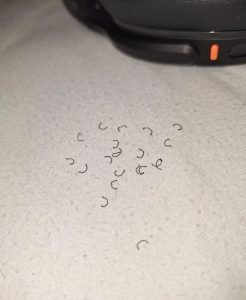Have you ever woken up and spotted tiny curled shavings on your bedsheets, your desk, or even on your wrist after taking off your smartwatch? These odd little bits often resemble miniature Velcro hooks—small, curved fragments that look like they’ve been sliced from something soft yet durable. What’s even more puzzling is when you know for certain you haven’t used Velcro anywhere near your sleeping area or workspace. So where in the world are they coming from?

As strange as they might seem at first, these mysterious little curls have a very simple and surprisingly common origin: the band of your smartwatch or fitness tracker. If your strap is made of silicone or rubber—and that includes a huge number of fitness wearables—you’ve probably seen these fragments before without realizing it. While they may seem random or even a bit alarming, they’re a perfectly natural byproduct of everyday wear and tear.
What you’re actually seeing are tiny pieces of your band that have worn down and broken off over time. Think of your strap like a well-worn trail—each step, each bit of movement adds a little more wear. Eventually, even the most durable materials can start to break apart, especially in areas that see repeated bending or rubbing. And because many smartwatch bands are made from silicone or synthetic rubber, the degradation doesn’t always look like cracking or stretching. Instead, the material tends to shed in these small, curled fragments that uncannily resemble the hooks on Velcro strips.
Several everyday factors contribute to this phenomenon. First and foremost is good old-fashioned friction. When you wear your watch daily, you’re constantly twisting your wrist, adjusting the strap, and putting pressure on specific points of the band. Even casual movements, like typing on a keyboard or resting your wrist on a desk or table, can contribute to microscopic abrasions. These tiny but constant rubs act like sandpaper over time, gradually shaving off pieces of the strap material.
Sweat and natural body oils are also major culprits. If you’re someone who wears your watch while exercising, sleeping, or during hot summer days, your skin naturally produces sweat and oil that can seep under the band. This moisture can soften the rubber or silicone and make it more susceptible to breaking down. The material might not seem like it’s suffering any damage at first glance, but over time, the chemical interaction between your skin and the strap can lead to slow erosion, particularly in cheaper or older bands.
Speaking of which, not all bands are created equal. If you’re using an inexpensive strap from a third-party seller or one that came with your device years ago, it’s far more likely to show signs of early wear. Lower-grade silicone and rubber can start breaking down within a few months of heavy use, especially if exposed to the elements or not cleaned regularly. In contrast, higher-quality materials—like fluoroelastomer, which is used in many premium smartwatch bands—are built to endure heat, sweat, friction, and time much better. These upgraded materials resist shredding and cracking, often lasting for years before showing any signs of fatigue.
Now, before you panic about finding these shavings, let’s be clear: they’re not harmful. They don’t pose any threat to your health, your skin, or the internal workings of your smartwatch. What they are, however, is a signal. A subtle one. A sign that your current band is starting to show its age and may not be holding up as well as it once did. If you begin to notice more frequent flaking, or if you spot any cracks in the strap or irritation where the band touches your skin, it might be time to consider a replacement.
Luckily, there are several simple steps you can take to either prevent this kind of wear or at least delay it significantly. The first thing you can do is keep your band clean. It might sound obvious, but regular cleaning goes a long way. Use mild soap and warm water once or twice a week to wash away sweat, skin oils, and dust particles that can speed up deterioration. After workouts or beach days, a quick rinse can help remove salt and other residues that are especially tough on rubber materials.
Another great habit is rotating between different bands. If you own more than one strap, try switching them out every few days. This gives each band a chance to breathe, dry out fully, and avoid constant exposure to friction or sweat. It also extends the life of all your bands since you’re distributing the wear more evenly.
Reducing friction during the day is also a smart move. If you notice that your watch constantly rubs against your shirt cuff, desk, or armrest, consider adjusting your position. Loosen your sleeves, shift how you rest your arm, or even try a slightly looser watch fit if it’s comfortable. These minor changes can reduce daily abrasion and make a big difference over time.
Finally, when the time comes to buy a new band, consider investing in one made from a more durable material. Sure, it might cost a bit more upfront, but a high-quality strap can last far longer and maintain a cleaner, more polished look. You’ll not only save money in the long run but also enjoy a more comfortable wearing experience.
So the next time you find those strange, Velcro-like curls on your bedsheets, don’t worry—you’re not alone, and you’re definitely not imagining things. It’s just your smartwatch doing what all well-used tools eventually do: showing signs of wear. These tiny fragments aren’t something to fear, but rather something to understand. They remind us that even the smallest pieces of technology need a little care and attention. By taking steps to protect your strap now, you’ll keep your watch looking great, your wrist feeling comfortable, and your mornings free from mysterious shavings.





